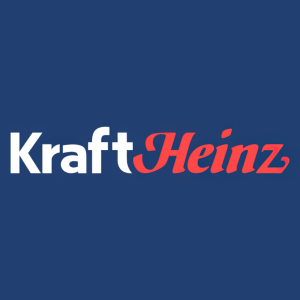Kraft Heinz Reports Fourth Quarter and Full Year 2020 Results
The Kraft Heinz Company (Nasdaq: KHC) (“Kraft Heinz” or the “Company”) today reported financial results for the fourth quarter and full year 2020.
“Our people’s unwavering commitment during this pandemic has been remarkable, and through it, our organization has rediscovered its agility. This has accelerated our transformation and led to the strong performance we are reporting today,” said Kraft Heinz CEO Miguel Patricio. “We set our multi-year transformation plan this time last year. We exceeded that plan in 2020. We are increasingly confident that we will again exceed that plan in 2021. We have started the new year with our new operating model fully in place. We have momentum at our back. We are well-prepared to meet the uncertainties of this dynamic environment, as well as the challenges facing the consumers we serve.”
Net Sales |
||||||||||||||
In millions |
||||||||||||||
|
|
Net Sales |
|
Organic Net Sales(1) Growth |
||||||||||
|
|
December 26, 2020 |
|
December 28, 2019 |
|
% Chg vs PY |
|
YoY Growth Rate |
|
Price |
|
Volume/Mix |
||
For the Three Months Ended |
|
|
|
|
|
|
|
|
|
|||||
United States(3) |
|
$ |
5,082 |
|
$ |
4,702 |
|
|
|
|
|
5.2 pp |
|
2.8 pp |
International(3) |
|
1,410 |
|
1,377 |
|
|
|
|
|
2.0 pp |
|
(0.1) pp |
||
Canada |
|
447 |
|
457 |
|
(2.0)% |
|
(3.1)% |
|
7.9 pp |
|
(11.0) pp |
||
Kraft Heinz |
|
$ |
6,939 |
|
$ |
6,536 |
|
|
|
|
|
4.8 pp |
|
1.2 pp |
|
|
|
|
|
|
|
|
|
|
|
|
|
||
For the Year Ended |
|
|
|
|
|
|
|
|
|
|
|
|
||
United States(3) |
|
$ |
19,204 |
|
$ |
17,844 |
|
|
|
|
|
3.5 pp |
|
4.1 pp |
International(3) |
|
5,341 |
|
5,251 |
|
|
|
|
|
2.1 pp |
|
2.6 pp |
||
Canada |
|
1,640 |
|
1,882 |
|
(12.8)% |
|
(0.1)% |
|
2.2 pp |
|
(2.3) pp |
||
Kraft Heinz |
|
$ |
26,185 |
|
$ |
24,977 |
|
|
|
|
|
3.1 pp |
|
3.4 pp |
Net Income/(Loss) Attributable to Common Shareholders and Diluted EPS |
||||||||||||||||
In millions, except per share data |
||||||||||||||||
|
|
For the Three Months Ended |
|
For the Year Ended |
||||||||||||
|
|
December 26, 2020 |
|
December 28, 2019 |
|
% Chg vs PY |
|
December 26, 2020 |
|
December 28, 2019 |
|
% Chg vs PY |
||||
Gross Profit |
|
$ |
2,523 |
|
$ |
2,107 |
|
|
|
$ |
9,177 |
|
$ |
8,147 |
|
|
Operating income/(loss) |
|
1,550 |
|
594 |
|
|
|
2,128 |
|
3,070 |
|
(30.7)% |
||||
Net income/(loss) attributable to common shareholders |
|
1,032 |
|
182 |
|
|
|
356 |
|
1,935 |
|
(81.6)% |
||||
Diluted EPS |
|
$ |
0.84 |
|
$ |
0.15 |
|
|
|
$ |
0.29 |
|
$ |
1.58 |
|
(81.6)% |
|
|
|
|
|
|
|
|
|
|
|
|
|
||||
Adjusted EPS(1) |
|
0.80 |
|
0.72 |
|
|
|
2.88 |
|
2.85 |
|
|
||||
Adjusted EBITDA(1) |
|
$ |
1,788 |
|
$ |
1,564 |
|
|
|
$ |
6,669 |
|
$ |
6,064 |
|
|
Q4 2020 Financial Summary
-
Net sales increased 6.2 percent versus the year-ago period to
$6.9 billion , including a favorable 0.2 percentage point impact from currency. Organic Net Sales increased 6.0 percent driven by sustained growth momentum in retail, partially offset by ongoing weakness in foodservice and a negative 1.4 percentage point impact from exiting the McCafé licensing agreement. Pricing increased 4.8 percentage points reflecting favorable trade expense timing versus the year-ago period, lower sales on promotion during holiday event periods relative to comparable prior year, primarily in the United States, as well as reduced promotional activity in capacity-constrained areas to better safeguard customer service. Volume/mix was up 1.2 percentage points versus the year-ago period from continued at-home consumption growth due, in part, to the COVID-19 pandemic. This growth was partially offset by foodservice declines, the negative impact from exiting the McCafé licensing agreement, and unfavorable changes in retail inventory levels. -
Net income attributable to common shareholders increased 467.5 percent versus the year-ago period to
$1.0 billion and Diluted EPS increased to$0.84 , up 460.0 percent versus the prior year primarily due to non-cash impairment charges in the prior year period that did not repeat and, to a lesser extent, gross profit growth versus the year-ago period. -
Adjusted EPS increased to
$0.80 , up 11.1 percent versus the prior year, primarily driven by Adjusted EBITDA growth that more than offset an unfavorable, non-cash impact from lower amortization of prior service credits within other expense/(income) and higher stock-based compensation expenses versus the year-ago period, as well as higher taxes on adjusted earnings in the current period. -
Adjusted EBITDA increased 14.3 percent versus the year-ago period to
$1.8 billion , including a favorable 0.2 percentage point impact from currency. Excluding the impact of currency, Adjusted EBITDA growth was driven by pricing gains, productivity efficiencies, favorable mix, and volume growth relative to the prior year period. This growth was partially offset by higher supply chain costs, including COVID-19-related expenses, as well as increased incentive compensation and significant investments in marketing and sales. -
Net cash provided by operating activities increased to
$4.9 billion in 2020, up 38.7 percent versus the prior year reflecting Adjusted EBITDA growth, as well as favorable changes in current liabilities, primarily due to the timing of payments. These factors, together with lower capital expenditures versus the prior year period, resulted in Free Cash Flow(1) of$4.3 billion in 2020, up 55.5 percent versus the prior year.
Outlook
The Company continues to expect it will deliver 2021 financial performance ahead of its strategic plan.
Based on performance to date, the Company believes flat-to-positive growth in Organic Net Sales(2) and low-single-digit Constant Currency Adjusted EBITDA(2) growth versus the prior year period are reasonable expectations for first-quarter 2021 performance. The Company also notes that this performance takes into consideration comparisons with a strong first-quarter 2020 period that included an approximate 6 to 7 percentage point contribution to Organic Net Sales(2) growth and an approximate 9 to 10 percentage point contribution to Constant Currency Adjusted EBITDA(2) growth versus the first quarter of 2019 due to increased consumer demand related to the COVID-19 pandemic.
End Notes
(1) |
Organic Net Sales, Adjusted EBITDA, Constant Currency Adjusted EBITDA, Adjusted EPS, and Free Cash Flow are non-GAAP financial measures. Please see discussion of non-GAAP financial measures and the reconciliations at the end of this press release for more information. |
(2) |
First quarter 2021 guidance for Organic Net Sales and Constant Currency Adjusted EBITDA is provided on a non-GAAP basis only because certain information necessary to calculate the most comparable GAAP measure is unavailable due to the uncertainty and inherent difficulty of predicting the occurrence and the future financial statement impact of such items impacting comparability, including, but not limited to, the impact of currency, acquisitions and divestitures, integration and restructuring expenses, deal costs, unrealized losses/(gains) on commodity hedges, impairment losses, and equity award compensation expense, among other items. Therefore, as a result of the uncertainty and variability of the nature and amount of future adjustments, which could be significant, the Company is unable to provide a reconciliation of these measures without unreasonable effort. |
(3) |
In the first quarter of 2020, the Company’s internal reporting and reportable segments changed. The Puerto Rico business was moved from the Latin America zone to the United States zone to consolidate and streamline the management of the Company's product categories and supply chain. The Company also combined its Europe, Middle East, and Africa (EMEA), Latin America, and Asia Pacific (APAC) zones to form the International zone. Therefore, effective in the first quarter of 2020, the Company manages and reports its operating results through three reportable segments defined by geographic region: United States, International, and Canada. The Company has reflected these changes in all historical periods presented. |
Earnings Discussion and Webcast Information
A pre-recorded management discussion of The Kraft Heinz Company's fourth quarter and full year 2020 earnings conference call is available at ir.kraftheinzcompany.com. The Company will host a live question-and-answer session today at 9:00 a.m. Eastern Standard Time. A webcast of the session will be accessible at ir.kraftheinzcompany.com.
ABOUT THE KRAFT HEINZ COMPANY
We are driving transformation at The Kraft Heinz Company (Nasdaq: KHC), inspired by our Purpose, Let's Make Life Delicious. Consumers are at the center of everything we do. With 2020 net sales of approximately
Forward-Looking Statements
This press release contains a number of forward-looking statements. Words such as “plan,” "believe," "anticipate," "reflect," "invest," "see," "make," "expect," "deliver," "drive," “improve,” “intend,” "assess," "remain," "evaluate," “establish,” “focus,” “build,” “turn,” “expand,” “leverage,” "grow," "will," and variations of such words and similar future or conditional expressions are intended to identify forward-looking statements. Examples of forward-looking statements include, but are not limited to, statements regarding the Company's plans, impacts of accounting standards and guidance, growth, legal matters, taxes, costs and cost savings, impairments, dividends, expectations, investments, innovations, opportunities, capabilities, execution, initiatives, and pipeline. These forward-looking statements reflect management's current expectations and are not guarantees of future performance and are subject to a number of risks and uncertainties, many of which are difficult to predict and beyond the Company's control.
Important factors that may affect the Company's business and operations and that may cause actual results to differ materially from those in the forward-looking statements include, but are not limited to, the impacts of the novel coronavirus COVID-19 pandemic and government and consumer responses; operating in a highly competitive industry; the Company’s ability to correctly predict, identify, and interpret changes in consumer preferences and demand, to offer new products to meet those changes, and to respond to competitive innovation; changes in the retail landscape or the loss of key retail customers; changes in the Company's relationships with significant customers or suppliers, or in other business relationships; the Company’s ability to maintain, extend, and expand its reputation and brand image; the Company’s ability to leverage its brand value to compete against private label products; the Company’s ability to drive revenue growth in its key product categories or platforms, increase its market share, or add products that are in faster-growing and more profitable categories; product recalls or other product liability claims; the Company’s ability to identify, complete, or realize the benefits from strategic acquisitions, alliances, divestitures, joint ventures, or other investments; the Company's ability to successfully execute its strategic initiatives; the impacts of the Company's international operations; the Company's ability to protect intellectual property rights; the Company's ownership structure; the Company’s ability to realize the anticipated benefits from prior or future streamlining actions to reduce fixed costs, simplify or improve processes, and improve its competitiveness; the Company's level of indebtedness, as well as our ability to comply with covenants under our debt instruments; additional impairments of the carrying amounts of goodwill or other indefinite-lived intangible assets; foreign exchange rate fluctuations; volatility in commodity, energy, and other input costs; volatility in the market value of all or a portion of the commodity derivatives we use; compliance with laws, regulations, and related interpretations and related legal claims or other regulatory enforcement actions, including additional risks and uncertainties related to any potential actions resulting from the Securities and Exchange Commission’s (“SEC”) ongoing investigation, as well as potential additional subpoenas, litigation, and regulatory proceedings; failure to maintain an effective system of internal controls; a downgrade in the Company's credit rating; the impact of future sales of the Company's common stock in the public market; the Company’s ability to continue to pay a regular dividend and the amounts of any such dividends; unanticipated business disruptions and natural events in the locations in which the Company or the Company's customers, suppliers, distributors, or regulators operate; economic and political conditions in the United States and in various other nations where the Company does business; changes in the Company's management team or other key personnel and the Company's ability to hire or retain key personnel or a highly skilled and diverse global workforce; risks associated with information technology and systems, including service interruptions, misappropriation of data, or breaches of security; increased pension, labor, and people-related expenses; changes in tax laws and interpretations; volatility of capital markets and other macroeconomic factors; and other factors. For additional information on these and other factors that could affect the Company's forward-looking statements, see the Company's risk factors, as they may be amended from time to time, set forth in its filings with the SEC. The Company disclaims and does not undertake any obligation to update, revise, or withdraw any forward-looking statement in this press release, except as required by applicable law or regulation.
Non-GAAP Financial Measures
The non-GAAP financial measures provided should be viewed in addition to, and not as an alternative for, results prepared in accordance with accounting principles generally accepted in the United States of America (“GAAP”) that are presented in this press release.
To supplement the financial information provided, the Company has presented Organic Net Sales, Adjusted EBITDA, Constant Currency Adjusted EBITDA, Adjusted EPS, and Free Cash Flow which are considered non-GAAP financial measures. The non-GAAP financial measures presented may differ from similarly titled non-GAAP financial measures presented by other companies, and other companies may not define these non-GAAP financial measures in the same way. These measures are not substitutes for their comparable GAAP financial measures, such as net sales, net income/(loss), diluted earnings per share, or other measures prescribed by GAAP, and there are limitations to using non-GAAP financial measures.
Management uses these non-GAAP financial measures to assist in comparing the Company's performance on a consistent basis for purposes of business decision making by removing the impact of certain items that management believes do not directly reflect the Company's underlying operations. Management believes that presenting the Company's non-GAAP financial measures (i.e., Organic Net Sales, Adjusted EBITDA, Constant Currency Adjusted EBITDA, Adjusted EPS, and Free Cash Flow) is useful to investors because it (i) provides investors with meaningful supplemental information regarding financial performance by excluding certain items, (ii) permits investors to view performance using the same tools that management uses to budget, make operating and strategic decisions, and evaluate historical performance, and (iii) otherwise provides supplemental information that may be useful to investors in evaluating the Company's results. The Company believes that the presentation of these non-GAAP financial measures, when considered together with the corresponding GAAP financial measures and the reconciliations to those measures, provides investors with additional understanding of the factors and trends affecting the Company's business than could be obtained absent these disclosures.
Organic Net Sales is defined as net sales excluding, when they occur, the impact of currency, acquisitions and divestitures, and a 53rd week of shipments. The Company calculates the impact of currency on net sales by holding exchange rates constant at the previous year's exchange rate, with the exception of highly inflationary subsidiaries, for which the Company calculates the previous year's results using the current year's exchange rate. Organic Net Sales is a tool that can assist management and investors in comparing the Company's performance on a consistent basis by removing the impact of certain items that management believes do not directly reflect the Company's underlying operations.
Adjusted EBITDA is defined as net income/(loss) from continuing operations before interest expense, other expense/(income), provision for/(benefit from) income taxes, and depreciation and amortization (excluding integration and restructuring expenses); in addition to these adjustments, the Company excludes, when they occur, the impacts of integration and restructuring expenses, deal costs, unrealized losses/(gains) on commodity hedges, impairment losses, and equity award compensation expense (excluding integration and restructuring expenses). The Company also presents Adjusted EBITDA on a constant currency basis. The Company calculates the impact of currency on Adjusted EBITDA by holding exchange rates constant at the previous year's exchange rate, with the exception of highly inflationary subsidiaries, for which it calculates the previous year's results using the current year's exchange rate. Adjusted EBITDA and Constant Currency Adjusted EBITDA are tools that can assist management and investors in comparing the Company's performance on a consistent basis by removing the impact of certain items that management believes do not directly reflect the Company's underlying operations.
Adjusted EPS is defined as diluted earnings per share excluding, when they occur, the impacts of integration and restructuring expenses, deal costs, unrealized losses/(gains) on commodity hedges, impairment losses, losses/(gains) on the sale of a business, other losses/(gains) related to acquisitions and divestitures (e.g., tax and hedging impacts), nonmonetary currency devaluation (e.g., remeasurement gains and losses), debt prepayment and extinguishment costs, and U.S. Tax Reform discrete income tax expense/(benefit), and including when they occur, adjustments to reflect preferred stock dividend payments on an accrual basis. The Company believes Adjusted EPS provides important comparability of underlying operating results, allowing investors and management to assess operating performance on a consistent basis.
Free Cash Flow is defined as net cash provided by/(used for) operating activities less capital expenditures. The Company believes Free Cash Flow provides a measure of the Company's core operating performance, the cash-generating capabilities of the Company's business operations, and is one factor used in determining the amount of cash available for debt repayments, dividends, acquisitions, share repurchases, and other corporate purposes. The use of this non-GAAP measure does not imply or represent the residual cash flow for discretionary expenditures since the Company has certain non-discretionary obligations such as debt service that are not deducted from the measure.
See the attached schedules for supplemental financial data, which includes the financial information, the non-GAAP financial measures and corresponding reconciliations to the comparable GAAP financial measures for the relevant periods.
|
|
||||||||||
Schedule 1 |
|||||||||||
The Kraft Heinz Company
|
|||||||||||
|
For the Three Months Ended |
|
For the Year Ended |
||||||||
|
December 26, 2020 |
|
December 28, 2019 |
|
December 26, 2020 |
|
December 28, 2019 |
||||
Net sales |
$ |
6,939 |
|
$ |
6,536 |
|
$ |
26,185 |
|
$ |
24,977 |
Cost of products sold |
4,416 |
|
4,429 |
|
17,008 |
|
16,830 |
||||
Gross profit |
2,523 |
|
2,107 |
|
9,177 |
|
8,147 |
||||
Selling, general and administrative expenses, excluding impairment losses |
973 |
|
837 |
|
3,650 |
|
3,178 |
||||
Goodwill impairment losses |
— |
|
453 |
|
2,343 |
|
1,197 |
||||
Intangible asset impairment losses |
— |
|
223 |
|
1,056 |
|
702 |
||||
Selling, general and administrative expenses |
973 |
|
1,513 |
|
7,049 |
|
5,077 |
||||
Operating income/(loss) |
1,550 |
|
594 |
|
2,128 |
|
3,070 |
||||
Interest expense |
328 |
|
326 |
|
1,394 |
|
1,361 |
||||
Other expense/(income) |
(64) |
|
(59) |
|
(296) |
|
(952) |
||||
Income/(loss) before income taxes |
1,286 |
|
327 |
|
1,030 |
|
2,661 |
||||
Provision for/(benefit from) income taxes |
252 |
|
144 |
|
669 |
|
728 |
||||
Net income/(loss) |
1,034 |
|
183 |
|
361 |
|
1,933 |
||||
Net income/(loss) attributable to noncontrolling interest |
2 |
|
1 |
|
5 |
|
(2) |
||||
Net income/(loss) attributable to common shareholders |
$ |
1,032 |
|
$ |
182 |
|
$ |
356 |
|
$ |
1,935 |
|
|
|
|
|
|
|
|
||||
Basic shares outstanding |
1,223 |
|
1,221 |
|
1,223 |
|
1,221 |
||||
Diluted shares outstanding |
1,230 |
|
1,225 |
|
1,228 |
|
1,224 |
||||
|
|
|
|
|
|
|
|
||||
Per share data applicable to common shareholders: |
|
|
|
|
|
|
|
||||
Basic earnings/(loss) per share |
$ |
0.84 |
|
$ |
0.15 |
|
$ |
0.29 |
|
$ |
1.59 |
Diluted earnings/(loss) per share |
0.84 |
|
0.15 |
|
0.29 |
|
1.58 |
||||
|
|
|
|
|
|
|
|
||||||||
Schedule 2 |
|||||||||||||||
The Kraft Heinz Company
|
|||||||||||||||
|
Net Sales |
|
Currency |
|
Acquisitions and Divestitures |
|
Organic Net Sales |
|
Price |
|
Volume/Mix |
||||
December 26, 2020 |
|
|
|
|
|
|
|
|
|
|
|
||||
United States |
$ |
5,082 |
|
$ |
— |
|
$ |
— |
|
$ |
5,082 |
|
|
|
|
International |
1,410 |
|
14 |
|
— |
|
1,396 |
|
|
|
|
||||
Canada |
447 |
|
4 |
|
— |
|
443 |
|
|
|
|
||||
Kraft Heinz |
$ |
6,939 |
|
$ |
18 |
|
$ |
— |
|
$ |
6,921 |
|
|
|
|
|
|
|
|
|
|
|
|
|
|
|
|
||||
December 28, 2019 |
|
|
|
|
|
|
|
|
|
|
|
||||
United States |
$ |
4,702 |
|
$ |
— |
|
$ |
— |
|
$ |
4,702 |
|
|
|
|
International |
1,377 |
|
7 |
|
— |
|
1,370 |
|
|
|
|
||||
Canada |
457 |
|
— |
|
— |
|
457 |
|
|
|
|
||||
Kraft Heinz |
$ |
6,536 |
|
$ |
7 |
|
$ |
— |
|
$ |
6,529 |
|
|
|
|
| Year-over-year growth rates |
|
||||||||||||||
United States |
|
|
|
0.0 pp |
|
|
0.0 pp |
|
|
|
|
5.2 pp |
|
2.8 pp |
|
International |
|
|
|
0.5 pp |
|
|
0.0 pp |
|
|
|
|
2.0 pp |
|
(0.1) pp |
|
Canada |
(2.0)% |
|
|
1.1 pp |
|
|
0.0 pp |
|
|
(3.1)% |
|
7.9 pp |
|
(11.0) pp |
|
Kraft Heinz |
|
|
|
0.2 pp |
|
|
0.0 pp |
|
|
|
|
4.8 pp |
|
1.2 pp |
|
|
|
|
|
|
|
|
|||||||||
Schedule 3 |
|||||||||||||||
The Kraft Heinz Company
|
|||||||||||||||
|
Net Sales |
|
Currency |
|
Acquisitions and Divestitures |
|
Organic Net Sales |
|
Price |
|
Volume/Mix |
||||
December 26, 2020 |
|
|
|
|
|
|
|
|
|
|
|
||||
United States |
$ |
19,204 |
|
$ |
— |
|
$ |
— |
|
$ |
19,204 |
|
|
|
|
International |
5,341 |
|
(114) |
|
— |
|
5,455 |
|
|
|
|
||||
Canada |
1,640 |
|
(21) |
|
— |
|
1,661 |
|
|
|
|
||||
Kraft Heinz |
$ |
26,185 |
|
$ |
(135) |
|
$ |
— |
|
$ |
26,320 |
|
|
|
|
|
|
|
|
|
|
|
|
|
|
|
|
||||
December 28, 2019 |
|
|
|
|
|
|
|
|
|
|
|
||||
United States |
$ |
17,844 |
|
$ |
— |
|
$ |
— |
|
$ |
17,844 |
|
|
|
|
International |
5,251 |
|
27 |
|
13 |
|
5,211 |
|
|
|
|
||||
Canada |
1,882 |
|
— |
|
219 |
|
1,663 |
|
|
|
|
||||
Kraft Heinz |
$ |
24,977 |
|
$ |
27 |
|
$ |
232 |
|
$ |
24,718 |
|
|
|
|
Year-over-year growth rates |
|
|
|
|
|
|
|
|
|
|
|
United States |
|
|
0.0 pp |
|
0.0 pp |
|
|
|
3.5 pp |
|
4.1 pp |
International |
|
|
(2.7) pp |
|
(0.3) pp |
|
|
|
2.1 pp |
|
2.6 pp |
Canada |
(12.8)% |
|
(1.1) pp |
|
(11.6) pp |
|
(0.1)% |
|
2.2 pp |
|
(2.3) pp |
Kraft Heinz |
|
|
(0.7) pp |
|
(1.0) pp |
|
|
|
3.1 pp |
|
3.4 pp |
|
|
||||||||||
Schedule 4 |
|||||||||||
The Kraft Heinz Company
|
|||||||||||
|
For the Three Months Ended |
|
For the Year Ended |
||||||||
|
December 26, 2020 |
|
December 28, 2019 |
|
December 26, 2020 |
|
December 28, 2019 |
||||
Net income/(loss) |
$ |
1,034 |
|
$ |
183 |
|
$ |
361 |
|
$ |
1,933 |
Interest expense |
328 |
|
326 |
|
1,394 |
|
1,361 |
||||
Other expense/(income) |
(64) |
|
(59) |
|
(296) |
|
(952) |
||||
Provision for/(benefit from) income taxes |
252 |
|
144 |
|
669 |
|
728 |
||||
Operating income/(loss) |
1,550 |
|
594 |
|
2,128 |
|
3,070 |
||||
Depreciation and amortization (excluding integration and restructuring expenses) |
233 |
|
255 |
|
955 |
|
985 |
||||
Integration and restructuring expenses |
3 |
|
46 |
|
15 |
|
102 |
||||
Deal costs |
(1) |
|
— |
|
8 |
|
19 |
||||
Unrealized losses/(gains) on commodity hedges |
(53) |
|
(27) |
|
(6) |
|
(57) |
||||
Impairment losses |
14 |
|
676 |
|
3,413 |
|
1,899 |
||||
Equity award compensation expense (excluding integration and restructuring expenses) |
42 |
|
20 |
|
156 |
|
46 |
||||
Adjusted EBITDA |
$ |
1,788 |
|
$ |
1,564 |
|
$ |
6,669 |
|
$ |
6,064 |
|
|
|
|
|
|
|
|
||||
Segment Adjusted EBITDA: |
|
|
|
|
|
|
|
||||
United States |
$ |
1,507 |
|
$ |
1,273 |
|
$ |
5,557 |
|
$ |
4,829 |
International |
261 |
|
239 |
|
1,058 |
|
1,004 |
||||
Canada |
121 |
|
116 |
|
389 |
|
487 |
||||
General corporate expenses |
(101) |
|
(64) |
|
(335) |
|
(256) |
||||
Adjusted EBITDA |
$ |
1,788 |
|
$ |
1,564 |
|
$ |
6,669 |
|
$ |
6,064 |
|
|
|||||||
Schedule 5 |
||||||||
The Kraft Heinz Company
|
||||||||
|
Adjusted EBITDA |
|
Currency |
|
Constant Currency Adjusted EBITDA |
|||
December 26, 2020 |
|
|
|
|
|
|||
United States |
$ |
1,507 |
|
$ |
— |
|
$ |
1,507 |
International |
261 |
|
7 |
|
254 |
|||
Canada |
121 |
|
2 |
|
119 |
|||
General corporate expenses |
(101) |
|
(2) |
|
(99) |
|||
Kraft Heinz |
$ |
1,788 |
|
$ |
7 |
|
$ |
1,781 |
|
|
|
|
|
|
|||
December 28, 2019 |
|
|
|
|
|
|||
United States |
$ |
1,273 |
|
$ |
— |
|
$ |
1,273 |
International |
239 |
|
4 |
|
235 |
|||
Canada |
116 |
|
— |
|
116 |
|||
General corporate expenses |
(64) |
|
— |
|
(64) |
|||
Kraft Heinz |
$ |
1,564 |
|
$ |
4 |
|
$ |
1,560 |
Year-over-year growth rates |
|
|
|
|
|
United States |
|
|
0.0 pp |
|
|
International |
|
|
1.6 pp |
|
|
Canada |
|
|
1.2 pp |
|
|
General corporate expenses |
|
|
1.6 pp |
|
|
Kraft Heinz |
|
|
0.2 pp |
|
|
|
|
|||||||
Schedule 6 |
||||||||
The Kraft Heinz Company
|
||||||||
|
Adjusted EBITDA |
|
Currency |
|
Constant Currency Adjusted EBITDA |
|||
December 26, 2020 |
|
|
|
|
|
|||
United States |
$ |
5,557 |
|
$ |
— |
|
$ |
5,557 |
International |
1,058 |
|
(10) |
|
1,068 |
|||
Canada |
389 |
|
(5) |
|
394 |
|||
General corporate expenses |
(335) |
|
(1) |
|
(334) |
|||
Kraft Heinz |
$ |
6,669 |
|
$ |
(16) |
|
$ |
6,685 |
|
|
|
|
|
|
|||
December 28, 2019 |
|
|
|
|
|
|||
United States |
$ |
4,829 |
|
$ |
— |
|
$ |
4,829 |
International |
1,004 |
|
13 |
|
991 |
|||
Canada |
487 |
|
— |
|
487 |
|||
General corporate expenses |
(256) |
|
— |
|
(256) |
|||
Kraft Heinz |
$ |
6,064 |
|
$ |
13 |
|
$ |
6,051 |
Year-over-year growth rates |
|
|
|
|
|
United States |
|
|
0.0 pp |
|
|
International |
|
|
(2.4) pp |
|
|
Canada |
(20.2)% |
|
(1.0) pp |
|
(19.2)% |
General corporate expenses |
|
|
0.2 pp |
|
|
Kraft Heinz |
|
|
(0.5) pp |
|
|
|
|
||||
Schedule 7 |
|||||
The Kraft Heinz Company
|
|||||
|
For the Three Months Ended |
||||
|
December 26, 2020 |
|
December 28, 2019 |
||
Diluted EPS |
$ |
0.84 |
|
$ |
0.15 |
Integration and restructuring expenses(a) |
(0.01) |
|
0.03 |
||
Unrealized losses/(gains) on commodity hedges(b) |
(0.03) |
|
(0.02) |
||
Impairment losses(c) |
— |
|
0.49 |
||
Losses/(gains) on sale of business(d) |
(0.01) |
|
0.06 |
||
Debt prepayment and extinguishment costs(e) |
0.01 |
|
0.01 |
||
Adjusted EPS |
$ |
0.80 |
|
$ |
0.72 |
(a) |
Gross expenses/(income) included in integration and restructuring expenses were income of |
|
|
• |
Cost of products sold included income of |
|
• |
SG&A included expenses of |
|
• |
Other expense/(income) included income of |
(b) |
Gross expenses/(income) included in unrealized losses/(gains) on commodity hedges were income of |
|
(c) |
Gross impairment losses included the following: |
|
|
• |
Goodwill impairment losses of |
|
• |
Intangible asset impairment losses of |
|
• |
Property, plant and equipment asset impairment losses of |
(d) |
Gross expenses/(income) included in losses/(gains) on sale of business were expenses of less than |
|
(e) |
Gross expenses included in debt prepayment and extinguishment costs were |
|
|
|
|
|
|
||||
Schedule 8 |
|||||
The Kraft Heinz Company
|
|||||
|
For the Year Ended |
||||
|
December 26, 2020 |
|
December 28, 2019 |
||
Diluted EPS |
$ |
0.29 |
|
$ |
1.58 |
Integration and restructuring expenses(a) |
— |
|
0.07 |
||
Deal costs(b) |
— |
|
0.02 |
||
Unrealized losses/(gains) on commodity hedges(c) |
— |
|
(0.04) |
||
Impairment losses(d) |
2.59 |
|
1.38 |
||
Losses/(gains) on sale of business(e) |
(0.01) |
|
(0.23) |
||
Nonmonetary currency devaluation(f) |
— |
|
0.01 |
||
Debt prepayment and extinguishment costs(g) |
0.08 |
|
0.06 |
||
U.S. Tax Reform discrete income tax expense/(benefit)(h) |
(0.07) |
|
— |
||
Adjusted EPS |
$ |
2.88 |
|
$ |
2.85 |
(a) |
Gross expenses/(income) included in integration and restructuring expenses were income of |
|
|
• |
Cost of products sold included income of |
|
• |
SG&A included expenses of |
|
• |
Other expense/(income) included income of |
(b) |
Gross expenses included in deal costs were |
|
(c) |
Gross expenses/(income) included in unrealized losses/(gains) on commodity hedges were income of |
|
(d) |
Gross impairment losses included the following: |
|
|
• |
Goodwill impairment losses of |
|
• |
Intangible asset impairment losses of |
|
• |
Property, plant and equipment asset impairment losses of |
(e) |
Gross expenses/(income) included in losses/(gains) on sale of business were expenses of |
|
(f) |
Gross expenses included in nonmonetary currency devaluation were |
|
(g) |
Gross expenses included in debt prepayment and extinguishment costs were |
|
(h) |
U.S. Tax Reform discrete income tax expense/(benefit) included a benefit of |
|
|
|
|||||||
Schedule 9 |
||||||||
The Kraft Heinz Company
|
||||||||
|
For the Three Months Ended |
|
|
|||||
|
December 26, 2020 |
|
December 28, 2019 |
|
$ Change |
|||
Key drivers of change in Adjusted EPS: |
|
|
|
|
|
|||
Results of operations(a) |
$ |
0.98 |
|
$ |
0.84 |
|
$ |
0.14 |
Interest expense |
(0.20) |
|
(0.21) |
|
0.01 |
|||
Other expense/(income)(b) |
0.03 |
|
0.09 |
|
(0.06) |
|||
Effective tax rate |
(0.01) |
|
— |
|
(0.01) |
|||
Adjusted EPS |
$ |
0.80 |
|
$ |
0.72 |
|
0.08 |
|
(a) |
Includes non-cash amortization of definite-lived intangible assets, which accounted for a negative impact to Adjusted EPS from results of operations of |
(b) |
Includes non-cash amortization of prior service credits, which accounted for a benefit to Adjusted EPS from other expense/(income) of |
|
|
|||||||
Schedule 10 |
||||||||
The Kraft Heinz Company
|
||||||||
|
For the Year Ended |
|
|
|||||
|
December 26, 2020 |
|
December 28, 2019 |
|
$ Change |
|||
Key drivers of change in Adjusted EPS: |
|
|
|
|
|
|||
Results of operations(a) |
$ |
3.67 |
|
$ |
3.28 |
|
$ |
0.39 |
Results of divested operations |
— |
|
0.04 |
|
(0.04) |
|||
Interest expense |
(0.84) |
|
(0.83) |
|
(0.01) |
|||
Other expense/(income)(b) |
0.19 |
|
0.36 |
|
(0.17) |
|||
Effective tax rate and other |
(0.14) |
|
— |
|
(0.14) |
|||
Adjusted EPS |
$ |
2.88 |
|
$ |
2.85 |
|
0.03 |
|
(a) |
Includes non-cash amortization of definite-lived intangible assets, which accounted for a negative impact to Adjusted EPS from results of operations of |
(b) |
Includes non-cash amortization of prior service credits, which accounted for a benefit to Adjusted EPS from other expense/(income) of |
|
|
||||
Schedule 11 |
|||||
The Kraft Heinz Company
|
|||||
|
December 26, 2020 |
|
December 28, 2019 |
||
ASSETS |
|
|
|
||
Cash and cash equivalents |
$ |
3,417 |
|
$ |
2,279 |
Trade receivables, net |
2,063 |
|
1,973 |
||
Inventories |
2,554 |
|
2,721 |
||
Prepaid expenses |
351 |
|
384 |
||
Other current assets |
574 |
|
618 |
||
Assets held for sale |
1,863 |
|
122 |
||
Total current assets |
10,822 |
|
8,097 |
||
Property, plant and equipment, net |
6,876 |
|
7,055 |
||
Goodwill |
33,089 |
|
35,546 |
||
Intangible assets, net |
46,667 |
|
48,652 |
||
Other non-current assets |
2,376 |
|
2,100 |
||
TOTAL ASSETS |
$ |
99,830 |
|
$ |
101,450 |
LIABILITIES AND EQUITY |
|
|
|
||
Commercial paper and other short-term debt |
$ |
6 |
|
$ |
6 |
Current portion of long-term debt |
230 |
|
1,022 |
||
Trade payables |
4,304 |
|
4,003 |
||
Accrued marketing |
946 |
|
647 |
||
Interest payable |
358 |
|
384 |
||
Other current liabilities |
2,200 |
|
1,804 |
||
Liabilities held for sale |
17 |
|
9 |
||
Total current liabilities |
8,061 |
|
7,875 |
||
Long-term debt |
28,070 |
|
28,216 |
||
Deferred income taxes |
11,462 |
|
11,878 |
||
Accrued postemployment costs |
243 |
|
273 |
||
Other non-current liabilities |
1,751 |
|
1,459 |
||
TOTAL LIABILITIES |
49,587 |
|
49,701 |
||
Redeemable noncontrolling interest |
— |
|
— |
||
Equity: |
|
|
|
||
Common stock, |
12 |
|
12 |
||
Additional paid-in capital |
55,096 |
|
56,828 |
||
Retained earnings/(deficit) |
(2,694) |
|
(3,060) |
||
Accumulated other comprehensive income/(losses) |
(1,967) |
|
(1,886) |
||
Treasury stock, at cost |
(344) |
|
(271) |
||
Total shareholders' equity |
50,103 |
|
51,623 |
||
Noncontrolling interest |
140 |
|
126 |
||
TOTAL EQUITY |
50,243 |
|
51,749 |
||
TOTAL LIABILITIES AND EQUITY |
$ |
99,830 |
|
$ |
101,450 |
|
|
||||
Schedule 12 |
|||||
The Kraft Heinz Company
|
|||||
|
For the Year Ended |
||||
|
December 26, 2020 |
|
December 28, 2019 |
||
CASH FLOWS FROM OPERATING ACTIVITIES: |
|
|
|
||
Net income/(loss) |
$ |
361 |
|
$ |
1,933 |
Adjustments to reconcile net income/(loss) to operating cash flows: |
|
|
|
||
Depreciation and amortization |
969 |
|
994 |
||
Amortization of postretirement benefit plans prior service costs/(credits) |
(122) |
|
(306) |
||
Equity award compensation expense |
156 |
|
46 |
||
Deferred income tax provision/(benefit) |
(343) |
|
(293) |
||
Postemployment benefit plan contributions |
(27) |
|
(32) |
||
Goodwill and intangible asset impairment losses |
3,399 |
|
1,899 |
||
Nonmonetary currency devaluation |
6 |
|
10 |
||
Loss/(gain) on sale of business |
2 |
|
(420) |
||
Other items, net |
81 |
|
(46) |
||
Changes in current assets and liabilities: |
|
|
|
||
Trade receivables |
(26) |
|
140 |
||
Inventories |
(266) |
|
(277) |
||
Accounts payable |
207 |
|
(58) |
||
Other current assets |
46 |
|
52 |
||
Other current liabilities |
486 |
|
(90) |
||
Net cash provided by/(used for) operating activities |
4,929 |
|
3,552 |
||
CASH FLOWS FROM INVESTING ACTIVITIES: |
|
|
|
||
Capital expenditures |
(596) |
|
(768) |
||
Payments to acquire business, net of cash acquired |
— |
|
(199) |
||
Proceeds from net investment hedges |
25 |
|
590 |
||
Proceeds from sale of business, net of cash disposed |
— |
|
1,875 |
||
Other investing activities, net |
49 |
|
13 |
||
Net cash provided by/(used for) investing activities |
(522) |
|
1,511 |
||
CASH FLOWS FROM FINANCING ACTIVITIES: |
|
|
|
||
Repayments of long-term debt |
(4,697) |
|
(4,795) |
||
Proceeds from issuance of long-term debt |
3,500 |
|
2,967 |
||
Debt prepayment and extinguishment costs |
(116) |
|
(99) |
||
Proceeds from revolving credit facility |
4,000 |
|
— |
||
Repayments of revolving credit facility |
(4,000) |
|
— |
||
Proceeds from issuance of commercial paper |
— |
|
557 |
||
Repayments of commercial paper |
— |
|
(557) |
||
Dividends paid |
(1,958) |
|
(1,953) |
||
Other financing activities, net |
(60) |
|
(33) |
||
Net cash provided by/(used for) financing activities |
(3,331) |
|
(3,913) |
||
Effect of exchange rate changes on cash, cash equivalents, and restricted cash |
62 |
|
(6) |
||
Cash, cash equivalents, and restricted cash |
|
|
|
||
Net increase/(decrease) |
1,138 |
|
1,144 |
||
Balance at beginning of period |
2,280 |
|
1,136 |
||
Balance at end of period |
$ |
3,418 |
|
$ |
2,280 |
|
|
||||
Schedule 13 |
|||||
The Kraft Heinz Company
|
|||||
|
For the Year Ended |
||||
|
December 26, 2020 |
|
December 28, 2019 |
||
Net cash provided by/(used for) operating activities |
$ |
4,929 |
|
$ |
3,552 |
Capital expenditures |
(596) |
|
(768) |
||
Free Cash Flow |
$ |
4,333 |
|
$ |
2,784 |
View source version on businesswire.com: https://www.businesswire.com/news/home/20210211005077/en/









